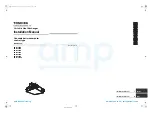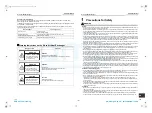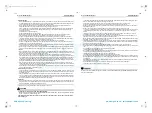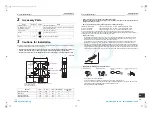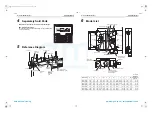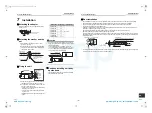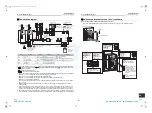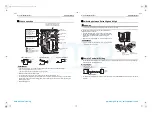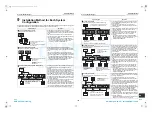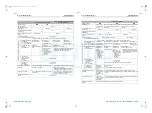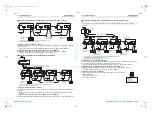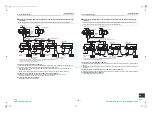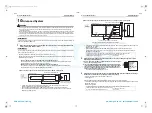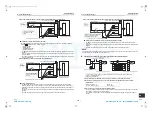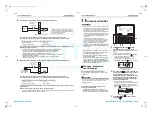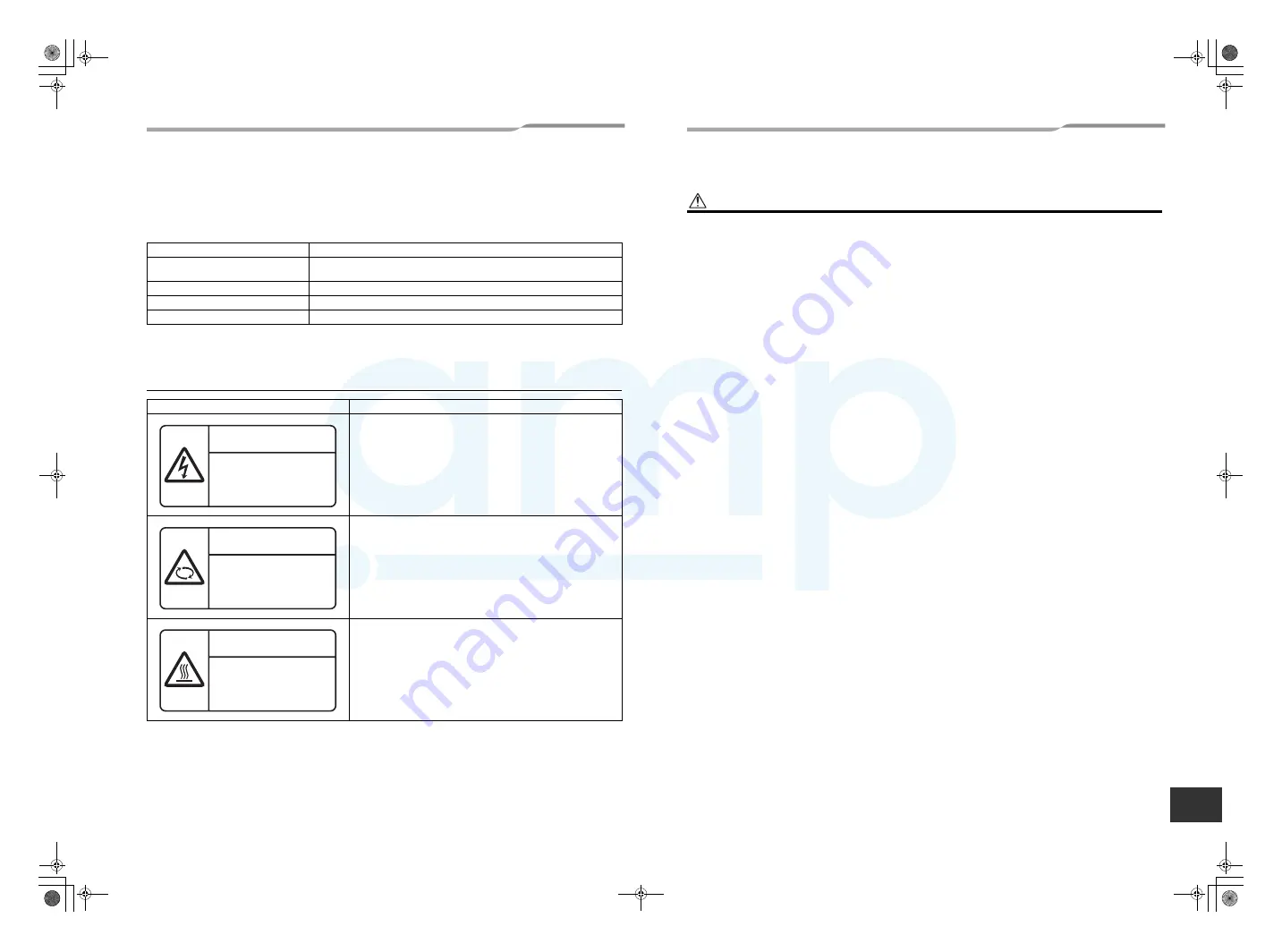
– 2 –
Air to Air Heat Exchanger
Installation Manual
EN
Air to Air Heat Exchanger
Installation Manual
Definition of Protective Gear
When the Air to Air Heat Exchanger is to be transported, installed, maintained, repaired or removed, wear
protective gloves and ‘safety’ work clothing.
In addition to such normal protective gear, wear the protective gear described below when undertaking the special
work detailed in the table below.
Failure to wear the proper protective gear is dangerous because you will be more susceptible to injury, burns,
electric shocks and other injuries.
Warning Indications on the Air to Air Heat Exchanger
Work undertaken
Protective gear worn
All types of work
Protective gloves
‘Safety’ working clothing
Electrical-related work
Gloves to provide protection for electricians and from heat
Work done at heights (50 cm or more)
Helmets for use in industry
Transportation of heavy objects
Shoes with additional protective toe cap
Warning indication
Description
WARNING
ELECTRICAL SHOCK HAZARD
Disconnect all remote electric power supplies before servicing.
WARNING
Moving parts.
Do not operate unit with inspection cover removed.
Stop the unit before the servicing.
CAUTION
High temperature parts.
You might get burned when removing this cover.
WARNING
ELECTRICAL SHOCK HAZARD
Disconnect all remote
electric power supplies
before servicing.
WARNING
Moving parts.
Do not operate unit with
inspection cover removed.
Stop the unit before the servicing.
CAUTION
High temperature parts.
You might get burned
when removing this cover.
1
Precautions for Safety
WARNING
General
• Before starting to install the Air to Air Heat Exchanger, read carefully through the Installation Manual, and follow its
instructions to install the Air to Air Heat Exchanger.
• Only a qualified installer(*1) or qualified service person(*1) is allowed to install the Air to Air Heat Exchanger. If the
Air to Air Heat Exchanger is installed by an unqualified individual, a fire, electric shocks, injury, water leakage, noise
and/or vibration may result.
• If using separately sold products, make sure to use Toshiba specified products only. Using unspecified products may
cause fire, electric shock, water leak or other failure.
• Before opening the electrical control cover or inspection cover of the Air to Air Heat Exchanger, set the circuit breaker
to the OFF position. Failure to set the circuit breaker to the OFF position may result in electric shocks through contact
with the interior parts. Only a qualified installer(*1) or qualified service person(*1) is allowed to remove the electrical
control cover or inspection cover of the Air to Air Heat Exchanger and do the work required.
• Before carrying out the installation, maintenance, repair or removal work, set the circuit breaker to the OFF position.
Otherwise, electric shocks may result.
• Place a “Work in progress” sign near the circuit breaker while the installation, maintenance, repair or removal work
is being carried out. There is a danger of electric shocks if the circuit breaker is set to ON by mistake.
• Only a qualified installer(*1) or qualified service person(*1) is allowed to undertake work at heights using a stand of
50 cm or more or to remove the electrical control cover or inspection cover of the Air to Air Heat Exchanger to
undertake work.
• Wear protective gloves and safety work clothing during installation, servicing and removal.
• When working at heights, use a ladder which complies with the ISO 14122 standard, and follow the procedure in the
ladder’s instructions. Also wear a helmet for use in industry as protective gear to undertake the work.
• When cleaning the filter or heat exchange element of the Air to Air Heat Exchanger, set the circuit breaker to OFF
without fail, and place a “Work in progress” sign near the circuit breaker before proceeding with the work.
• When working at heights, put a sign in place so that no-one will approach the work location, before proceeding with
the work. Parts and other objects may fall from above, possibly injuring a person below.
• The Air to Air Heat Exchanger must be transported in stable condition. In case an accident such as dropping of the
unit occurs while transporting the Air to Air Heat Exchanger, contact the dealer.
• Do not move or repair any unit by yourself. There is high voltage inside the unit. You may get electric shock when
removing the cover and main unit.
• Do not modify the products. Do not also disassemble or modify the parts. It may cause a fire, electric shock or injury.
• Confirm whether there is a risk of the Air to Air Heat Exchanger falling down during maintenance or repairing work.
• Before opening the Supply/Exhaust air grill, set the circuit breaker to the OFF position. Otherwise, your hand may be
caught in the rotating parts inside and an injury may result.
Selection of installation location
• Do not install the Air to Air Heat Exchanger in a location that may be subject to a risk of expire to a combustible gas.
If a combustible gas leaks and becomes concentrated around the unit, a fire may occur.
• When transporting the Air to Air Heat Exchanger, wear shoes with additional protective toe caps, protective gloves
and other protective clothing.
• When transporting the Air to Air Heat Exchanger, do not take hold of the bands around the packing carton. You may
injure yourself if the bands should break.
• Install the Air to Air Heat Exchanger at least 2.5 m above the floor level since otherwise the users may injure
themselves or receive electric shocks if they poke their fingers or other objects into the Air to Air Heat Exchanger
while it is running.
• Do not place any combustion appliance in a place where it is directly exposed to the wind of Air to Air Heat Exchanger,
otherwise it may cause imperfect combustion.
• Use a hand track or forklift to carry the unit. When carrying it by human power, have four persons or more; otherwise,
you may strain your back.
Installation
• When the Air to Air Heat Exchanger is to be suspended, the designated hanging bolts (M10 to M12) and nuts (M10
to M12) must be used.
• Install the Air to Air Heat Exchanger at enough strong places to withstand the weight of the unit. If the strength is not
enough, the unit may fall down resulting in injury.
• Follow the instructions in the Installation Manual to install the Air to Air Heat Exchanger. Failure to follow these
instructions may cause the product to fall down or topple over or give rise to noise, vibration, water leakage, etc.
3-EN
4-EN
+00ET9X463301_01EN.book Page 2 Thursday, January 20, 2011 4:41 PM
AMP Air Conditioning
www.ampair.co.uk | sales@ampair.co.uk

